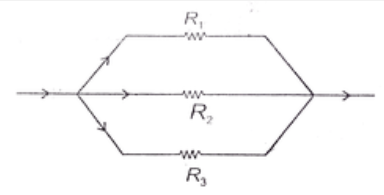Calculate equivalent resistance of two resistors R1andR2 in parallel where, R1=(6±0.2)ohm and R2=(3±0.1)ohm
The correct Answer is:B
To calculate the equivalent resistance of two resistors R1 and R2 in parallel, we will follow these steps:
Step 1: Write the formula for equivalent resistance in parallel
The formula for the equivalent resistance R of two resistors R1 and R2 connected in parallel is given by:
1R=1R1+1R2
Step 2: Substitute the values of R1 and R2
Given:
- R1=6Ω with an uncertainty of ±0.2Ω
- R2=3Ω with an uncertainty of ±0.1Ω
Substituting these values into the formula:
1R=16+13
Step 3: Calculate the right-hand side
Calculating the fractions:
16+13=16+26=36=12
Step 4: Find the equivalent resistance R
Now, taking the reciprocal to find R:
R=112=2Ω
Step 5: Calculate the maximum permissible error
To find the maximum permissible error in the equivalent resistance, we differentiate the equation for R:
−dRR2=−dR1R21−dR2R22
Rearranging gives:
dR=(dR1R21+dR2R22)R2
Step 6: Substitute the uncertainties and values
Given:
- dR1=0.2Ω
- dR2=0.1Ω
- R1=6Ω
- R2=3Ω
- R=2Ω
Substituting these values into the error formula:
dR=(0.262+0.132)(22)
Calculating each term:
0.236+0.19=0.236+0.436=0.636=160
Now, substituting back:
dR=(160)(4)=460=115≈0.0667Ω
Step 7: Final result with uncertainty
The equivalent resistance R with its uncertainty is:
R=2±0.07Ω
Summary
The equivalent resistance of the two resistors in parallel is:
R=2±0.07Ω
The formula for the equivalent resistance R of two resistors R1 and R2 connected in parallel is given by:
Given:
- R1=6Ω with an uncertainty of ±0.2Ω
- R2=3Ω with an uncertainty of ±0.1Ω
Calculating the fractions:
Now, taking the reciprocal to find R:
To find the maximum permissible error in the equivalent resistance, we differentiate the equation for R:
Given:
- dR1=0.2Ω
- dR2=0.1Ω
- R1=6Ω
- R2=3Ω
- R=2Ω
The equivalent resistance R with its uncertainty is:
The equivalent resistance of the two resistors in parallel is:
Topper's Solved these Questions
- MEASUREMENT AND ERRORSBook:DC PANDEY ENGLISHChapter:MEASUREMENT AND ERRORSExercise:Exercise 2.1
Explore 2 Videos
- MEASUREMENT AND ERRORSBook:DC PANDEY ENGLISHChapter:MEASUREMENT AND ERRORSExercise:Exercise 2.2
Explore 1 Video
- MAGNETIC EFFECT OF CURRENT AND MAGNETISMBook:DC PANDEY ENGLISHChapter:MAGNETIC EFFECT OF CURRENT AND MAGNETISMExercise:Integer type Questions
Explore 10 Videos
- MOTIONBook:DC PANDEY ENGLISHChapter:MOTIONExercise:Medical entrances gallery
Explore 19 Videos
Similar Questions
Write the expressions for the equivalent resistance R of three resistors R1,R2,andR3 joined in (a) parallel, and (b) series.
View SolutionTwo resistors of resistances R1=100±3 ohm and R2=200±4 ohm are connected (a) in series, (b) in parallel. Find the equivalent resistance of the (a) series combination, (b) parallel combination. Use for (a) the relation R=R1+R2 and for (b) 1R'=1R1+1R2 and ΔR'R'2=ΔR1R21+ΔR2R22
View SolutionTwo resistance R1 and R2 are made of different material. The temperature coefficient of the material of R1 is α and of the material of R2 is −β. Then resistance of the series combination of R1 and R2 will not change with temperature, if R1/R2 will not change with temperature if R1/R2 equals
View SolutionTwo resistance R1 and R2 are made of different material. The temperature coefficient of the material of R1 is α and of the material of R2 is −β. Then resistance of the series combination of R1 and R2 will not change with temperature, if R1/R2 will not change with temperature if R1/R2 equals
View SolutionTwo resistors of resistances R1=100±3 ohm and R2=200±4 ohm are connected (a) in series , (b) in parrallel. Find the equivalent resistance of the (a) series combination , (b) parallel combination . Use for (a) the relation R=R1+R2and for (b) 1R=1R1+1R2andΔR'R,2=ΔR1R21+ΔR2R22
View SolutionTwo resistors of resistances R1=100±3 ohm and R2=200±4 ohm are connected (a) in series , (b) in parrallel. Find the equivalent resistance of the (a) series combination , (b) parallel combination . Use for (a) the relation R=R1+R2and for (b) 1R=1R1+1R2andΔR'R,2=ΔR1R21+ΔR2R22
View SolutionTwo resistors of resistances R1=100±3 ohm and R2=200±4 ohm are connected (a) in series , (b) in parrallel. Find the equivalent resistance of the (a) series combination , (b) parallel combination . Use for (a) the relation R=R1+R2and for (b) 1R=1R1+1R2andΔR'R,2=ΔR1R21+ΔR2R22
View SolutionTwo resistors of resistances R1=100±3 ohm and R2=200±4 ohm are connected (a) in series , (b) in parrallel. Find the equivalent resistance of the (a) series combination , (b) parallel combination . Use for (a) the relation R=R1+R2and for (b) 1R=1R1+1R2andΔR'R,2=ΔR1R21+ΔR2R22
View SolutionIn the situation shown, resistance R1,R2 and R3 are in the ratio 3:2:1 , then

View SolutionFor the series combination of three resistors establish the relation :
R=R1+R2+R3
where the symbols have their usual meanings.
Calculate the equivalent resistance of the combination of three resistors of 6Ω,9Ω and 18Ω joined in parallel.
View Solution